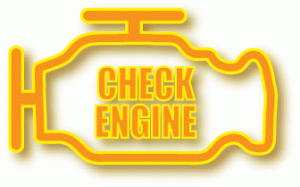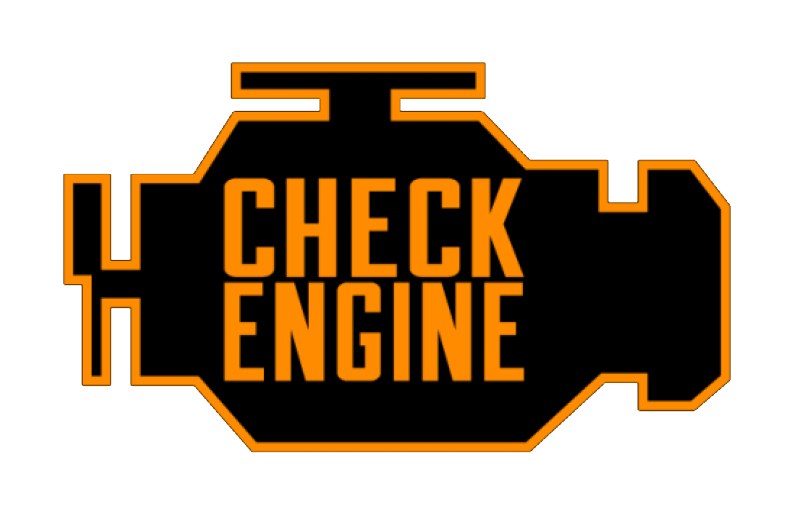 A solid glowing check engine light could be indicating a problem that is easily fixable. Your vehicle could require a simple adjustment or a replacement part.
A solid glowing check engine light could be indicating a problem that is easily fixable. Your vehicle could require a simple adjustment or a replacement part.
Driving long distances with this light activated could result in a larger problem down the road. It is safest for you and your passengers to learn what is going on with your vehicle sooner rather than later so that you can take the necessary measures to fix the issue.
Below is a list of a the major things that cause the light to stay on :
1. Fuel Filler Cap
You wouldn’t think a gas cap would be that important, but it is. When it’s loose or cracked, fuel vapours leak out and can throw the whole fuel system off. This causes a reduction in gas mileage and increases emissions.
What causes it: If you get an error pointing to the gas cap it means fuel vapours are leaking out of your cap. This means the cap is either cracked or just wasn’t tightened well enough.
What you should do: If your car isn’t feeling jerky or strange when the check engine light comes on the first you should check is the gas cap. Pull over, retighten it, and take a look at the cap to see if it has any cracks in it. Continue driving and see if the check engine light turns off. Alternately, you can purchase a gas cap from an auto parts store or dealer. All you need to do is take the old one off and screw on the new one. If you’ve already made it to the store, you might as well just replace it. While not car-threatening, it’s good to take care of this right away to improve gas mileage.
2. Mass Air Flow Sensor
The mass airflow sensor tells the car’s computer to add the proper amount of fuel based on the air coming through to the engine. A faulty one can increase emissions, cause the car to stall, and decrease fuel mileage.
What causes it: Most mass airflow sensors fail because of a improperly installed (or never replaced) air filter. You should replace the air filter at least once a year to help prevent the airflow sensor from failing.
What you should do: Theoretically you can drive for a few weeks or even months with a broken MAF sensor. You will notice a decrease in fuel mileage and over time the car will eventually start stalling a lot. It’s not terribly difficult to do on your own replacement, but the process is quick enough you may want to let a mechanic handle the project in case the sensor doesn’t end up being the issue.
3. Oxygen Sensor
An oxygen sensor is a part that monitors the unburned oxygen from the exhaust. It helps monitor how much fuel is burned. A faulty sensor means it’s not providing the right data to the computer and causes a decrease in gas mileage. Most cars have between two and four oxygen sensors and the code you get from the scanner will tell you which one needs replacing.
What causes it: Over time, the sensor gets covered in oil ash and it reduces the sensors ability to check the oxygen and fuel mixture. A faulty sensor not only reduces gas mileage, it also increase emissions.
What you should do: Not replacing a broken oxygen sensor can eventually lead to a busted catalytic convertor which can cost just increase your costs in the long run. However, an oxygen sensor is easy to replace on many cars and is usually detailed in the owner’s manual. If you know where the sensor is, you only have to unclip the old sensor and replace it with a new one. Regardless of how you approach it, you should get this fixed right away.
4. Catalytic Convertor
The catalytic convertor works to reduce exhaust gases. It converts carbon monoxide and other harmful materials into harmless compounds. If your catalytic convertor is failing, you’ll notice a decrease in gas mileage or your car won’t go any faster when you push the gas.
What causes it: Catalytic convertors shouldn’t fail if you’re keeping up on regular maintenance. The main cause of failure is related to other items on this list, including a broken oxygen sensor or deteriorated spark plugs. When it fails, it stops converting carbon monoxide into less harmful emissions.
What you should do: If your catalytic convertor fails completely, you eventually won’t be able to keep the car running. Your gas mileage will also be terrible, so you should try and fix it as soon as you can. Unfortunately, the average replacement cost is pretty high and you can’t do it yourself unless you’re an experienced mechanic.
5. Spark Plugs and Leads
The spark plug seals the combustion chamber and provides a gap for a spark to jump across and initiates combustion in your engine. When the plugs are failing, the spark plugs misfire. You’ll feel a little jolt in your car’s acceleration when this happens.
What causes it: Most spark plugs in Kenyan cars are replaced every 5,000 – 10,000 Kilometres. If you are driving a car made in the after 1996 and you use the recommended manufacturer plugs they can last up to 100,000 kilometres. Still, plugs fail over time and there’s not much you can do about it.
What you should do: Get them replaced right away. It’s easy and cheap and your car will run better for it. Since this is part of your vehicles regular maintenance, the spark plugs are usually easily accessible from the hood of the car. It’s simple enough in some cars that you can change them outside the shop in a few minutes.

